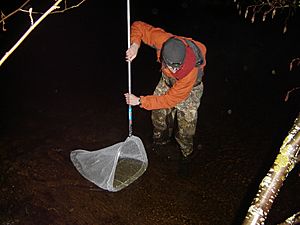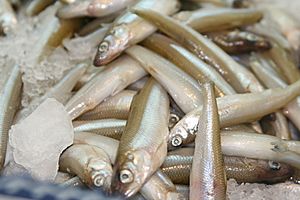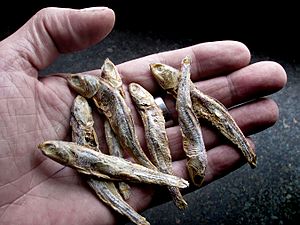Smelt (fish) facts for kids
Quick facts for kids Smelt |
|
|---|---|
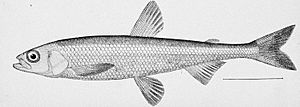 |
|
| Pond smelt (Hypomesus olidus) | |
| Scientific classification |
|
| Kingdom: | Animalia |
| Phylum: | Chordata |
| Class: | Actinopterygii |
| Order: | Osmeriformes |
| Suborder: | Osmeroidei |
| Family: | Osmeridae |
| Genera | |
|
Allosmerus |
|
Smelts are a group of small fish that belong to the family called Osmeridae. You can find them in the North Atlantic and North Pacific Oceans. They also live in rivers, streams, and lakes across Europe, North America, and Northeast Asia. Sometimes, people call them freshwater smelts or typical smelts to tell them apart from other similar fish.
Some types of smelt are very common in the Great Lakes in North America. They also live in the lakes and seas of northern Europe. These fish often swim in large schools along the coast. In spring, they travel to rivers to lay their eggs. However, in some western parts of the United States, the number of smelts has gone down a lot. Because of this, some species, like the Delta smelt and the eulachon, are now protected by law. This means people cannot catch them.
Smelts are one of the few fish that people are allowed to catch using special hand-held dip nets. They catch them either along the coast or in streams. Some people also enjoy ice fishing for smelt. Smelts are often cooked by frying them, and they are usually eaten whole.
Contents
What are Smelts?
Smelts usually grow to be about 20 centimeters (8 inches) long. However, some types can get much bigger, up to 70 centimeters (28 inches). Smelts are an important food source for many other fish. This includes bigger fish like salmon, striped bass, and lake trout.
Smelt Life Cycle and Migration
Many smelt species are like salmon because they are anadromous. This means they spend most of their lives in the sea. But when it's time to have babies, they travel into fresh water to breed. There are a few exceptions, though. For example, the surf smelt lives its whole life in the ocean.
Catching Smelts: Smelt Dipping
In the Canadian provinces and U.S. states around the Great Lakes, "smelt dipping" is a popular group activity. It happens in early spring when the stream water is around 4 degrees Celsius (39 degrees Fahrenheit). People use a flashlight or headlamp to spot the fish. Then, they scoop them out of the water using a dip net made of nylon or metal.
After catching them, people clean the smelts by taking off their heads and insides. The fins, scales, and bones are usually cooked along with the fish, unless the smelt is very large. Along the coast of Maine, catching smelts was also a sign that spring had arrived. People would catch many smelts by dipping a bucket into the small tidal streams.
Smelts as Food Around the World
Smelts are eaten in many different places. They are a tasty and important part of meals in various cultures.
Smelt Dishes in North America
In New England and the Maritime Provinces of Canada, smelts are an important fish to catch in winter. They are found in the saltwater parts of rivers. In the past, fishermen would go to their usual spots over the ice using horses and sleighs. Smelts caught from cold saltwater were thought to be better than those from warm water. These fish didn't sell for a lot of money, but there were so many of them that they provided extra income. The smelts would "flash freeze" just by being left on the ice. Then, they were sold to fish buyers who came down the rivers.
Today, smelts are caught in two main ways. Commercial fishermen use nets in the sea. People also catch them for fun by hand-netting, spearing, or fishing through holes in river ice. Smelts are often the main fish caught in small "fishing shack" villages that appear along frozen rivers. Common ways to cook them include pan-frying with flour and butter, or deep-frying in batter. Sometimes, they are even cooked right out of the water on small stoves inside the shacks.
Smelt Dishes in East Asia
Smelt is very popular in Japan. The species Sprinchus lanceolatus is often grilled and called shishamo, especially when it's full of eggs.
Smelt roe, which are the eggs, especially from capelin, are called masago in Japanese. They are yellow to orange in color and are often used in sushi.
Smelt is also served in dim sum restaurants. They are deep-fried with their heads and tails still on. They are known as duō chūn yú (多春鱼) or duō luǎn yú (多卵魚), which means "fish with many eggs."
Smelt is also a main fish eaten in Tamil Nadu as Nethili fry or Nethili karuvadu (dried fish). In coastal Karnataka, especially in Mangalore and Udupi, smelts are usually fried with heads and tails removed, or they are used in curries. They are called 'Bolingei' in Kannada and Tulu, and 'MotiyaLe' in Konkani.
Smelt Festivals and Celebrations
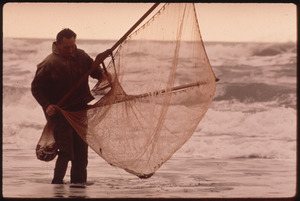
Many places around the world celebrate smelts with special festivals.
In the city of Inje, South Korea, an Ice Fishing Festival happens every year from January 30 to February 2. It takes place on Soyang Lake. This festival happens when the smelts swim into fresh water to lay their eggs. Locally, they are called bing-eo (빙어). People usually eat them raw or deep-fried.
In Finland, the province of Paltamo has yearly Norssikarnevaali festivals in the middle of May.
For some Italians, especially from the region of Calabria, fried smelts are a traditional part of the Christmas Eve dinner. This special dinner often has many courses of fish.
In 1956, the Chamber of Commerce in Kelso, Washington, called Kelso the "Smelt Capital of the World." Kelso is located on the Cowlitz River. They put up billboards and held festivals for the yearly smelt runs. However, the festivals stopped when the smelt runs became much smaller.
The village of Lewiston, New York, which is on the lower part of the Niagara River, has an annual two-day smelt festival. It takes place on the first weekend in May. During the festival, about 160 kilograms (350 pounds) of smelt are battered and fried at the Lewiston Waterfront. The smelt samples are free, but donations are welcome. These donations help support programs run by the Niagara River Anglers. The festival has a fun motto: "Lewiston never smelt so good."
Lithuania celebrates a yearly weekend smelt festival called "Palangos Stinta" in Palanga. It happens early every January.
The American Legion Post 82 in Port Washington, Wisconsin, has been hosting its annual Smelt Fry since 1951. Port Washington is on the western shore of Lake Michigan, north of Milwaukee. It has a long history as a fishing community. The Legion's Smelt Fry happens every year in mid to late April. In mid-July, the town also hosts its Fish Day event, which is known as "The world's largest, one-day, outdoor fish fry!"
When the smelts swim into the Neva River in Saint Petersburg, Russia, a Smelt Festival (Prazdnik koryushki) is celebrated. This river is at the head of the Gulf of Finland on the Baltic Sea.
The Magic Smelt Puppet Troupe from Duluth, Minnesota, has held an annual "Run, Smelt, Run!" parade since 2012. This event includes puppets, a smelt fry, and a dance party. The troupe also sometimes puts on other performances throughout the year.
Images for kids
See also
 In Spanish: Capellanes para niños
In Spanish: Capellanes para niños


